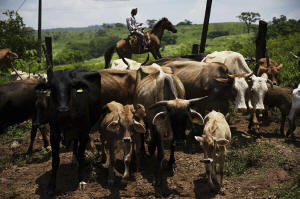Ranchers in southern Mexico are struggling against a flesh-eating
parasite infecting livestock
[July 25, 2025] By
RAÚL MENDOZA and ISABEL MATEOS
CINTALAPA, Mexico (AP) — With Mexican cattle again barred this month
from entry to the United States over fears of spreading a flesh-eating
parasite, ranchers and veterinarians in Mexico hundreds of miles from
the border are fighting what has U.S. agricultural authorities so on
edge.
In the southern state of Chiapas, which borders Guatemala, the New World
screwworm fly’s rapid spread appears to have caught most ranchers off
guard, despite memories of previous outbreaks in the 1980s and 1990s.
Mexico is building a plant with U.S. support in Chiapas to produce
sterile flies, which have proven effective at stopping the spread, but
it won’t be ready until next year. Meanwhile, the price of medicines
used to treat livestock infected with the screwworm have soared in
price.
That has led some to fall back on home remedies like applying gasoline
or lime to open wounds to coax out the worms.
In addition to the cost of the medicine, treatment requires careful
monitoring and usually involves multiple courses. Any open wound, even
very small ones, are an invitation to the fly to lay its eggs.
Veterinarian Alfredo Chávez left Chiapas to study in 1989, so he says he
missed seeing the effects of that outbreak, but now he’s seen cases
multiply in his corner of the state over the past month.

He’s heard of dozens of cases in the area now and treated about a dozen
himself. It’s not just cows either — sheep, pigs, cats and dogs are
targets as well.
Armed with a pair of blue tweezers and an aerosol spray that helps draw
the maggots out, Chávez moves from animal to animal. He puts maggots in
plastic tubes as samples, which he provides to agricultural authorities.
But beyond providing the tubes and encouraging ranchers to report cases,
he said that the government hasn't provided much help.
[to top of second column] |

A ranch worker drives cattle to a corral for inspection for New
World screwworm at a ranch in Cintalapa, Chiapas, Mexico, Wednesday,
July 23, 2025, amid an infestation that led the U.S. to suspend
cattle imports over fears the pest could reach the border. (AP
Photo/Isabel Mateos)
 “We’ve faced it alone,” he said
Wednesday.
The U.S. had just gradually started to reopen the border to cattle
imports this month after an earlier suspension in May, when the
Trump administration said that it would close it again after an
infected animal was found in the Gulf coast state of Veracruz. While
prevalent in Central America, the concern is that the fly is moving
north.
U.S. officials worry that if the fly reaches Texas, its maggots
could cause large economic losses, something that happened decades
ago.
Ranch caretaker Edi Valencia Santos said that Mexican government
officials have come to his community to talk to people with
livestock, but so far without resources. He has had five infected
animals on the ranch.
Despite cattle in this region going to domestic consumption rather
than to the U.S., the presence of the screwworm in Mexico has frozen
cattle exports to the U.S. nationwide.
Valencia said that he remembers the small planes distributing
sterile flies during those earlier outbreaks, so is optimistic they
will eventually help, but for now the costs are piling up on
ranchers.
“It’s a big, big problem in Chiapas,” he said.
All contents © copyright 2025 Associated Press. All rights reserved |